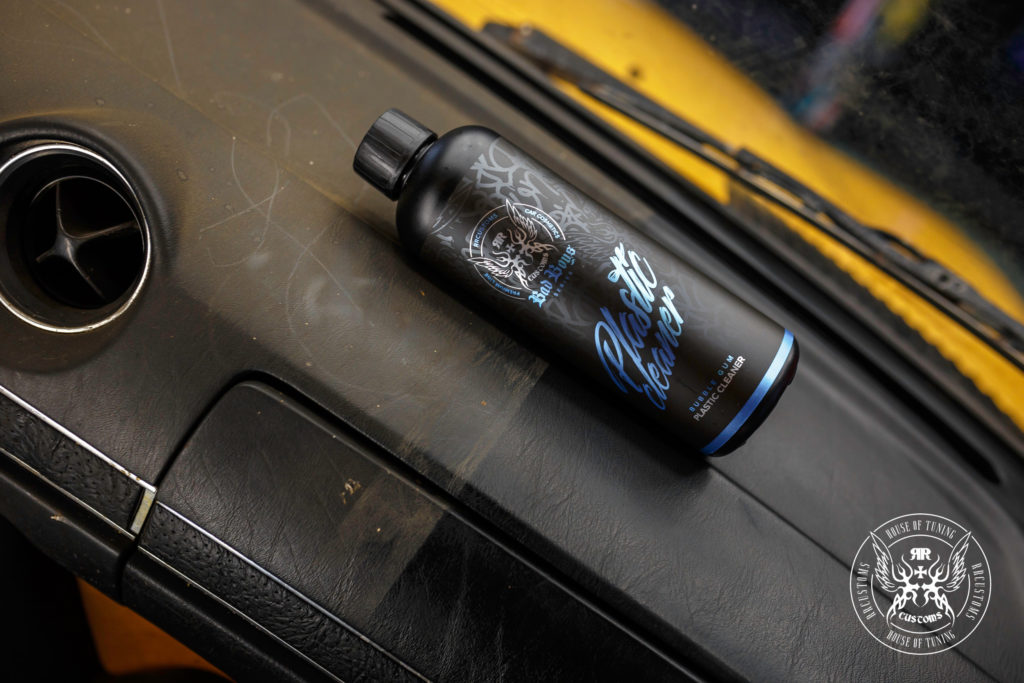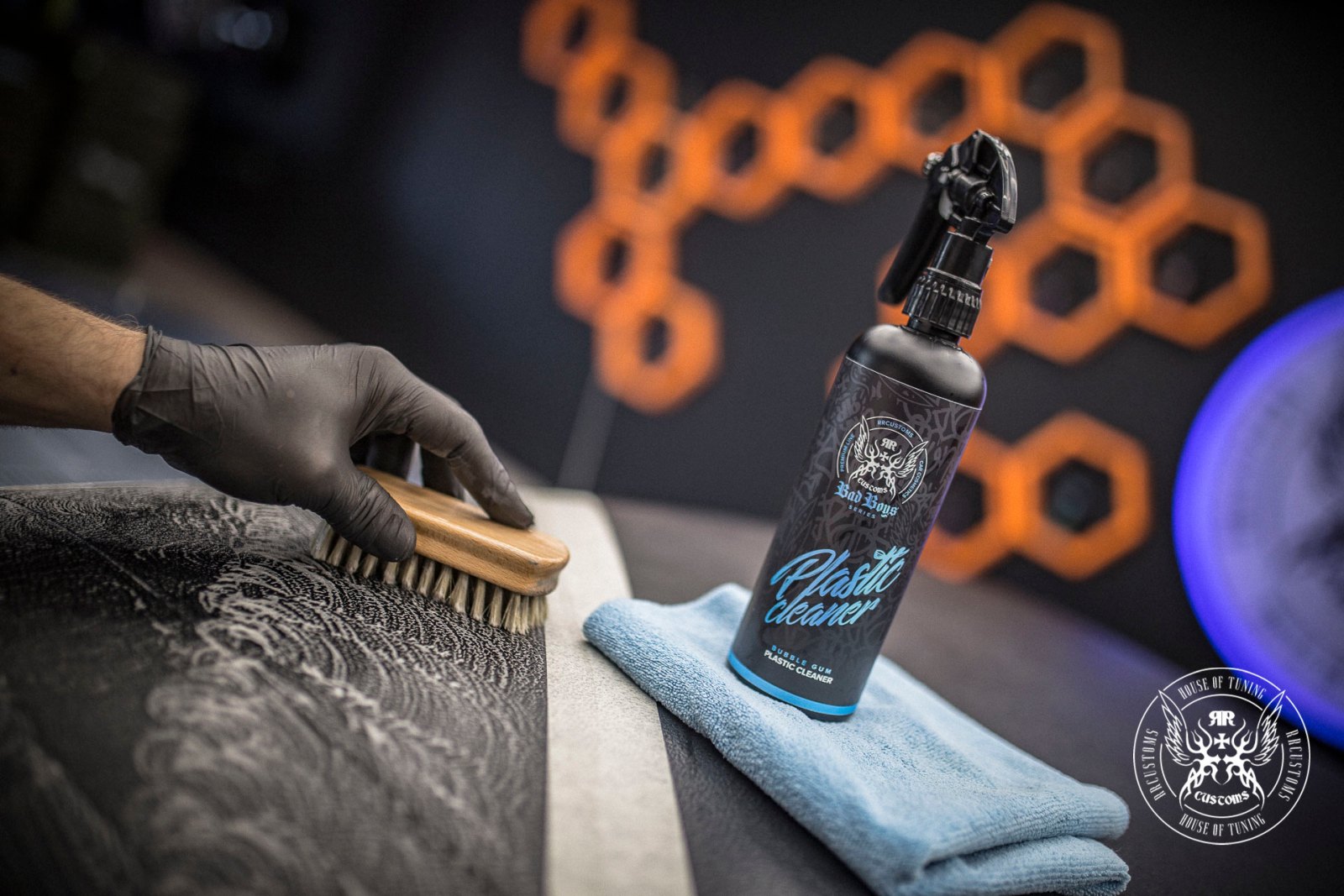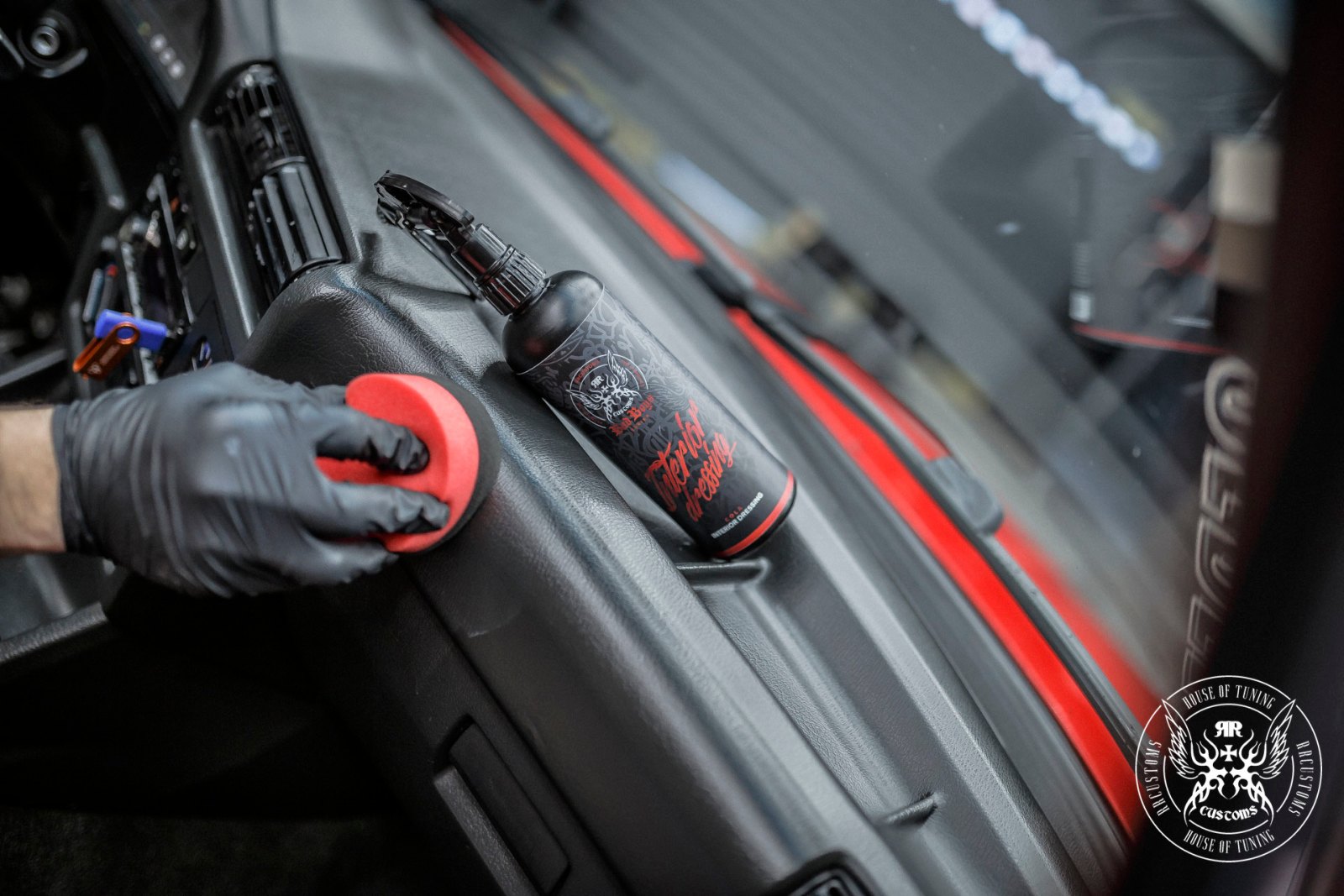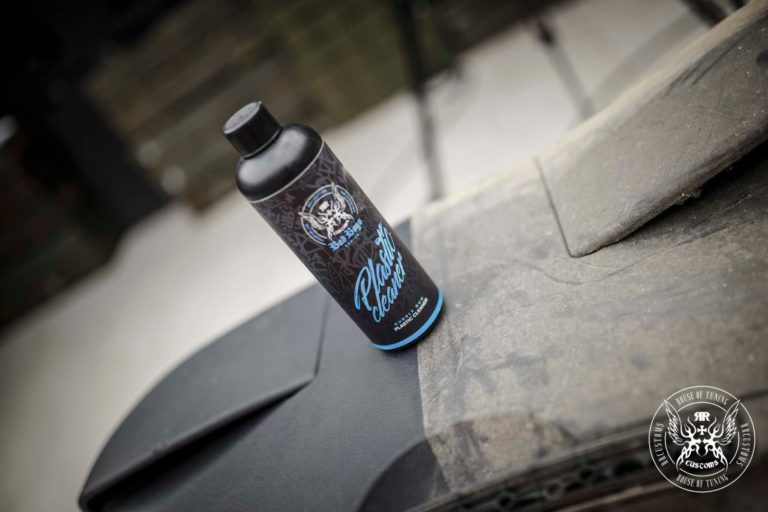
Keeping the interior of your car looking good involves more than just a car wash. Interior plastic and vinyl components, from the dashboard to the center console, often accumulate dust, stain, and grime. Want to know how to clean your car interior? Read this guide on cleaning car plastics.
1. What products should I use for cleaning the plastics in cars?
Wondering how to get your car’s interior looking like new? Our BadBoys Plastic Cleaner is your go-to choice for clean car plastics. It’s avialable in many different fragrances. Products that you can use for cleaning car plastics are:
2. BadBoys All-Purpose Cleaner: This is a versatile cleaner that can be used on various surfaces, including car plastics.
3. BadBoys Interior Detailer: This product is specifically designed to clean and protect car interiors, including plastics. It usually leaves a shiny, non-greasy finish.
4. BadBoys Interior Dressing: Great profuct for interior finishing
5. Microfiber cloth: While not a product per se, a microfiber cloth is an essential tool for cleaning car plastics. It is gentle on surfaces and helps remove dust and grime effectively.
Remember to always read and follow the instructions on the cleaning products you use, and test them on a small, inconspicuous area before applying them to larger surfaces.
All of theese products are avialable in our store.
2. Are there any household hacks for cleaning car plastics?
One of the most common ways to clean car plastics at home is with soap and water.
1. Mix mild dish soap with water.
2. Dip a clean cloth or sponge into the mixture and wring it out.
3. Gently scrub the plastic surfaces.
4. Wipe with a clean, damp cloth to remove any soapy residue and then dry.
Remember to always test any cleaning solution on a small, inconspicuous area before applying it to the entire surface. Household hacks can work, professional products specifically designed for cleaning car plastics often provide better and more consistent results.
3. How to remove greasy/oily stains from car plastics?
1. Start by obtaining a clean microfiber cloth. Microfiber cloths are excellent for cleaning car interiors as they are gentle and effective at lifting and trapping dirt and oils.
2. Gently wipe the oily marks on the car plastics using the microfiber cloth. Apply light pressure and use a back-and-forth motion to lift the grease. Avoid pressing too hard as it could smear or scratch the plastic surface.
3. If the oily stains persist, dampen the microfiber cloth slightly with water or a mild soapy solution. Wring out any excess liquid to avoid soaking the plastic surface.
4. Continue to wipe the greasy areas using the damp microfiber cloth. The water or soap will help break down the grease and make it easier to remove. Again, be gentle and avoid scrubbing vigorously.
5. After removing the greasy stains, dry the plastic surface thoroughly with a clean, dry microfiber cloth. Ensure that no moisture remains, as it could attract dirt or create water spots.
6. Finally, finish the cleaning process by applying a protectant specifically formulated for car plastics. These protectants help rejuvenate and maintain the appearance of the plastic surfaces while providing a layer of protection against future stains. Follow the instructions on the protectant product and apply it evenly on the cleaned plastic surfaces using a clean microfiber cloth.
7. Allow the protectant to dry as per the product instructions, and your car plastics should look clean and free of grease or oil stains.
Remember to always use caution when cleaning car plastics and test any cleaning products or protectants on a small, inconspicuous area before applying them to larger surfaces. This will ensure that there are no adverse reactions or damage to the plastics.
4. How to remove tough stains or drinks from car plastics?
1. Act quickly: If a beverage or drink is spilled on the dashboard, try to clean it as soon as possible. The longer the stain sits, the harder it will be to remove.
2. Prepare a cleaning solution: Mix a few drops of mild dish soap or all-purpose cleaner with warm water in a bucket or spray bottle. Avoid using harsh chemicals or ammonia-based cleaners as they may damage the plastic.
3. Test in a safe area: Before applying the cleaning solution to the stained area, test it in a small, hidden spot to ensure it doesn’t cause any discoloration or damage.
4. Apply the cleaning solution: Wet a clean microfiber cloth or sponge with the cleaning solution and gently rub the stained area. Be careful not to scrub too hard, as it may scratch the plastic surface.
5. Let it sit: Allow the cleaning solution to sit on the stain for a few minutes to penetrate and break up the dried residue.
6. Scrub gently: After letting the solution sit, use a soft-bristled brush or a toothbrush to scrub the stain gently. Work in a circular motion to loosen the stubborn residue.
7. Wipe clean: Dampen a clean microfiber cloth or sponge with plain water and wipe away the cleaning solution and loosened residue. Rinse the cloth or sponge frequently to avoid spreading the stain.
8. Dry the area: Use a dry microfiber cloth to remove any excess moisture and ensure the plastic is completely dry.
9. Repeat if necessary: For stubborn stains, you may need to repeat the process multiple times until the stain is fully removed. Be patient and persistent.
10. Apply a protective coating: Once the stain is removed, you can apply a plastic protectant or conditioner specifically designed for car plastics to restore shine and provide some level of protection against future stains.
Remember to always follow the manufacturer’s instructions for any cleaning products, and if you’re unsure, consult a professional detailer for advice.

5. What works better for cleaning car plastics? brush or cloth?
Both a soft-bristle brush and a microfibre cloth can be effective for cleaning car plastics. The choice between the two may depend on personal preference and the specific cleaning task at hand.
A soft-bristle brush is ideal for scrubbing away dirt and grime from textured or hard-to-reach areas. It can provide a thorough cleaning and help dislodge stubborn residue. However, care must be taken not to use a brush with overly stiff bristles, as this can potentially scratch or damage the plastic surface.
On the other hand, a microfibre cloth is excellent for wiping down smooth surfaces and removing dust, fingerprints, or light dirt. It is gentle on the plastic and less likely to cause any scratches or abrasions. Microfibre cloths are also absorbent, allowing them to pick up more dirt and leave surfaces clean and streak-free.
In summary, a soft-bristle brush is better suited for deeper cleaning, while a microfibre cloth is great for general wiping and maintenance cleaning of car plastics. It’s also worth noting that a combination of both tools can be used for a more comprehensive cleaning approach.
6. Is UV protection important in preserving car plastics?
Yes, UV protection is important in preserving car plastics. UV rays can cause the plastic surfaces to fade, crack, and deteriorate over time. By using products with UV filters, such as the ones from our BadBoys line, you can shield your car’s interior plastic from these harmful rays and help to maintain its appearance and durability.
7. How to remove gum from a plastic surface?
Here’s a simple method:
1. Freeze the gum: Take some ice cubes wrapped in a plastic bag and place them directly on the gum. Leave it for a few minutes until the gum hardens.
2. Scrape off the gum: Once the gum has hardened, use a plastic scraper or a credit card to gently scrape off the gum from the surface. Be careful not to scratch the material, so avoid using metal tools.
3. Clean the residue: After removing the gum, there might be some residue left behind. Moisten a cloth with warm, soapy water and gently wipe the area to remove any remaining gum residue.
4. Rinse and dry: Rinse the area with clean water, ensuring that all soap is removed, and then dry it thoroughly with a soft cloth.
Note: It’s always recommended to test any products or methods on a small, inconspicuous area first to ensure they do not cause any damage to the material.
8. How to restore dull plastic surfaces?
1. Apply a plastic dressing: One such product is BadBoys Interior Dressing. Follow the instructions provided on the product for best results.
2. Apply the product: Apply a small amount of the plastic restorer to a clean, lint-free cloth or applicator pad. Start by rubbing the product onto the plastic surface in circular motions, applying gentle pressure. Ensure even coverage across the entire surface.
3. Allow it to penetrate: Once the plastic restorer is applied, allow it to sit on the surface for the recommended time mentioned on the product packaging. This will allow the restorer to penetrate and work its magic.
4. Buff the surface: After the recommended time, use a clean cloth or microfiber towel to gently buff the surface. This will remove any excess product and restore the natural shine of the plastic.
5. Repeat if necessary: If the plastic surface is still dull or the desired shine is not achieved, you can repeat the process. However, be cautious not to apply too much product as it might cause buildup or an artificial shine.
6. Maintenance: To maintain the restored shine, regularly clean the plastic surface with a mild soap and water solution to prevent dirt buildup. Additionally, using a UV protectant spray can help prevent plastic from becoming dull due to sun exposure.
Remember to always follow the instructions provided by the specific product you choose to restore dull plastic surfaces.
9. What to avoid when cleaning car plastics?
Spraying cleaning products directly onto car plastics can lead to unintended consequences. It is advisable to avoid spraying products directly on the plastic parts as it may result in overspray on other elements or windows. Instead, spray the cleaning product onto a cloth microfiber and then gently wipe the plastic surfaces. This method allows you to have better control over where the product goes and prevents any damage to other areas of the car. Additionally, it is important to be cautious of using aggressive cleaners that may harm the plastic and cause discoloration or deterioration. Always read the instructions and use products specifically formulated for cleaning car plastics to avoid any potential damage.
10. How often should I maintain my car plastics?
It depends on the specific type of plastic and its exposure to various elements, but a general recommendation is to clean and maintain car plastics once every 3 to 6 months. Regular cleaning and conditioning can help prevent fading, cracking, and deterioration over time. However, if you notice any visible dirt, grime, or damage on the plastics, it is advised to clean and treat them as needed.

Thank you for reading our blog. We hope that our advice has benefited both experienced car enthusiasts and those who are just beginning their journey with detailing.
TABLE OF CONTENTS
- What products should I use for cleaning the plastics in cars?
- Are there any household hacks for cleaning car plastics?
- How to remove greasy/oily stains from car plastics?
- How to remove tough stains or drinks from car plastics?
- What works better for cleaning car plastics? brush or cloth?
- Is UV protection important in preserving car plastics?
- How to remove gum from a plastic surface?
- How to restore dull plastic surfaces?
- What to avoid when cleaning car plastics?
- How often should I maintain my car plastics?
